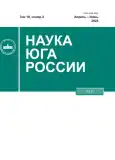МОДЕЛИРОВАНИЕ ЭФФЕКТИВНЫХ УПРУГИХ ХАРАКТЕРИСТИК И ПАРАМЕТРОВ АНИЗОТРОПИИ АНТИФРИКЦИОННЫХ ПОЛИМЕРНЫХ КОМПОЗИТОВ, АРМИРОВАННЫХ ОРИЕНТИРОВАННЫМИ ВОЛОКНАМИ
- Авторы: Колесников В.И1, Бардушкин В.В2, Сычев А.П3
-
Учреждения:
- Ростовский государственный университет путей сообщения
- Национальный исследовательский университет «МИЭТ»
- Федеральный исследовательский центр Южный научный центр Российской академии наук
- Выпуск: Том 19, № 2 (2023)
- Страницы: 6-12
- Раздел: Статьи
- URL: https://journals.eco-vector.com/2500-0640/article/view/627580
- DOI: https://doi.org/10.7868/S25000640230202
- ID: 627580
Цитировать
Полный текст
Аннотация
Рассматриваются многокомпонентные трибокомпозиты на основе эпоксидного связующего ЭД-20, армированные волокнами бесщелочного стекла и политетрафторэтилена. Полагается, что стеклянные волокна ориентированы вдоль осей x и y прямоугольной системы координат, а волокна политетрафторэтилена – только в направлении оси x. Это соответствует армированию материала стеклотканью, в которую вплетены политетрафторэтиленовые волокна. Построена модель, позволяющая выполнять численные расчеты значений эффективных упругих характеристик (компоненты тензора эффективных модулей упругости) и параметров упругой анизотропии указанных антифрикционных композитов. Модель опирается на обобщенное сингулярное приближение теории случайных полей, используемое при решении стохастического дифференциального уравнения равновесия упругой среды. Проведены численные расчеты значений эффективных упругих характеристик и параметров упругой анизотропии в направлениях осей x, y и z прямоугольной системы координат антифрикционных полимерных композитов, учитывающие изменения величин объемных концентраций их компонентов. При вычислении значений эффективных упругих характеристик модельных трибокомпозитов использовался метод самосогласования. Исследования показали, что увеличение содержания волокон политетрафторэтилена приводит к уменьшению значений эффективных модулей упругости и усилению анизотропии (особенно в направлении осей x и y прямоугольной системы координат) модельных антифрикционных композитов. Установлено, что при фиксированных концентрациях эпоксидного связующего и волокон политетрафторэтилена перераспределение (в направлениях осей x и y) объемной доли волокон бесщелочного стекла для некоторых компонент тензора эффективных модулей упругости приводит к увеличению их значений, а для других, наоборот, к уменьшению. При этом происходит усиление анизотропии в направлении оси x и ее ослабление в направлении оси y, значения параметра анизотропии в направлении оси z изменяются незначительно.
Об авторах
В. И Колесников
Ростовский государственный университет путей сообщенияРоссийская Федерация, 344038, г. Ростов-на-Дону
В. В Бардушкин
Национальный исследовательский университет «МИЭТ»Российская Федерация, 124498, г. Москва, Зеленоград
А. П Сычев
Федеральный исследовательский центр Южный научный центр Российской академии наук
Email: alekc_sap@mail.ru
Российская Федерация, 344006, г. Ростов-на-Дону
Список литературы
- Чичинадзе А.В., Матвеевский Р.М., Браун Э.Д. 1986. Материалы в триботехнике и в нестационарных процессах. М., Наука: 240 с.
- Машков Ю.К., Овчар З.Н., Байбарацкая М.Ю., Мамаев О.А. 2004. Полимерные композиционные материалы в триботехнике. М., Недра: 262 с.
- Колесников В.И., Бардушкин В.В., Яковлев В.Б., Сычев А.П., Колесников И.В. 2012. Микромеханика поликристаллов и композитов (напряженно-деформированное состояние и разрушение). Ростов н/Д, изд-во РГУПС: 288 с.
- Колесников И.В. 2012. Упругие характеристики трехкомпонентных антифрикционных композитов с ориентированными неизометричными включениями. Известия Петербургского университета путей сообщения. 32(3): 150–157.
- Бардушкин В.В., Колесников И.В., Флек Б.М., Сычев А.П., Яковлев В.Б. 2012. Упругие характеристики антифрикционных тканых композитов для тяжелонагруженных узлов трения. Трение и смазка в машинах и механизмах. 12: 13–18.
- Колесников В.И., Бардушкин В.В., Сычев А.П. 2017. Эксплуатационные упругие свойства хаотически армированных трибокомпозитов. Мир транспорта. 15(2): 38–46.
- Шермергор Т.Д. 1977. Теория упругости микронеоднородных сред. М., Наука: 399 с.
- Физические величины: справочник. 1991. М., Энергоатомиздат: 1232 с.
- Гутников С.И., Лазоряк Б.И., Селезнев А.Н. 2010. Стеклянные волокна. М., изд-во МГУ: 53 с.
- Лапицкий В.А., Крицук А.А. 1986. Физико-механические свойства эпоксидных полимеров и стеклопластиков. Киев, Наукова думка: 92 с.
- Паньков А.А. 2008. Методы самосогласования механики композитов. Пермь, изд-во Пермского государственного технического университета: 253 с.
Дополнительные файлы











